
Home
Services
About us
Blog
Contacts
Custom Mobile App Development for Smart Lawn Mowers: Unlocking Premium IoT Experiences for Homeowners & Landscapers
🧠 1. Introduction: The Rise of Smart Lawn Care
📊 2. Market Overview: The Booming Robotic Lawn Mower Industry
🤖 3. Understanding Smart Lawn Mowers: Features and Benefits
📱 4. The Role of Custom Mobile Apps in Enhancing User Experience
🛠️ 5. Technical Architecture: Building Robust and Scalable Solutions
- 5.1. Device Layer: Embedded Systems and Firmware
- 5.2. Connectivity Layer: Local and Cloud Communication
- 5.3. Cloud Infrastructure and Data Management
- 5.4. Mobile Application Layer
🧪 6. Challenges and Solutions in Developing Lawn Care Apps
🏆 7. Why Choose A-Bots.com for Your Smart Lawn Mower App Development
🔮 8. Conclusion: Embracing the Future of Smart Lawn Maintenance
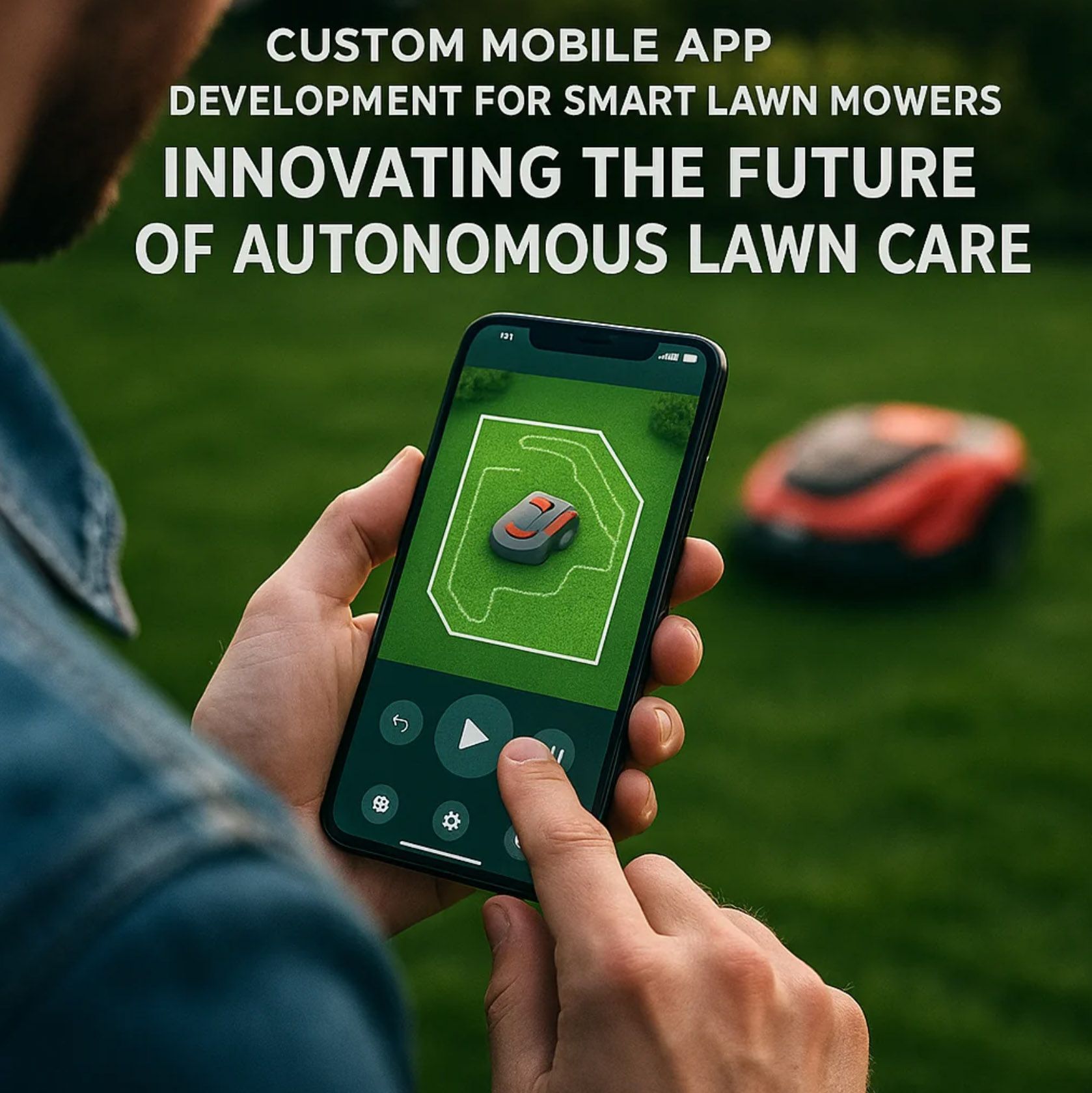
1. Introduction: The Rise of Smart Lawn Care
In recent years, the landscape of lawn maintenance has undergone a significant transformation. The advent of smart technology has introduced a new era where robotic lawn mowers are becoming an integral part of modern home automation systems. These devices offer homeowners a convenient, efficient, and eco-friendly solution to lawn care, seamlessly integrating with mobile applications for enhanced control and customization.
Market Growth and Trends
The global robotic lawn mower market is experiencing robust growth. According to Technavio, the market size is expected to reach USD 2.26 billion between 2025 and 2029, expanding at a CAGR of 22.4% during the forecast period. This surge is attributed to the increasing demand for automation in residential lawn maintenance and the growing adoption of smart home technologies (Arizton Advisory & Intelligence).
Technological Advancements
Modern robotic lawn mowers are equipped with advanced features that enhance their functionality and user experience:
- GPS Navigation and Virtual Boundaries: Devices like the Husqvarna Automower® 410XE NERA utilize satellite-based technology to define precise mowing areas without the need for physical boundary wires (Husqvarna Forest & Garden).
- Mobile App Integration: Users can control and monitor their mowers remotely through dedicated mobile applications, allowing for scheduling, zone management, and real-time status updates (Lifewire).
- Obstacle Detection and Safety Features: Built-in sensors enable mowers to detect and avoid obstacles, ensuring safe operation around pets and children.
Environmental and Lifestyle Benefits
The shift towards robotic lawn mowers also aligns with environmental sustainability goals. These battery-powered devices produce lower emissions compared to traditional gas-powered mowers and operate quietly, reducing noise pollution. Furthermore, they offer homeowners the convenience of automated lawn care, freeing up time for other activities (Arizton Advisory & Intelligence).
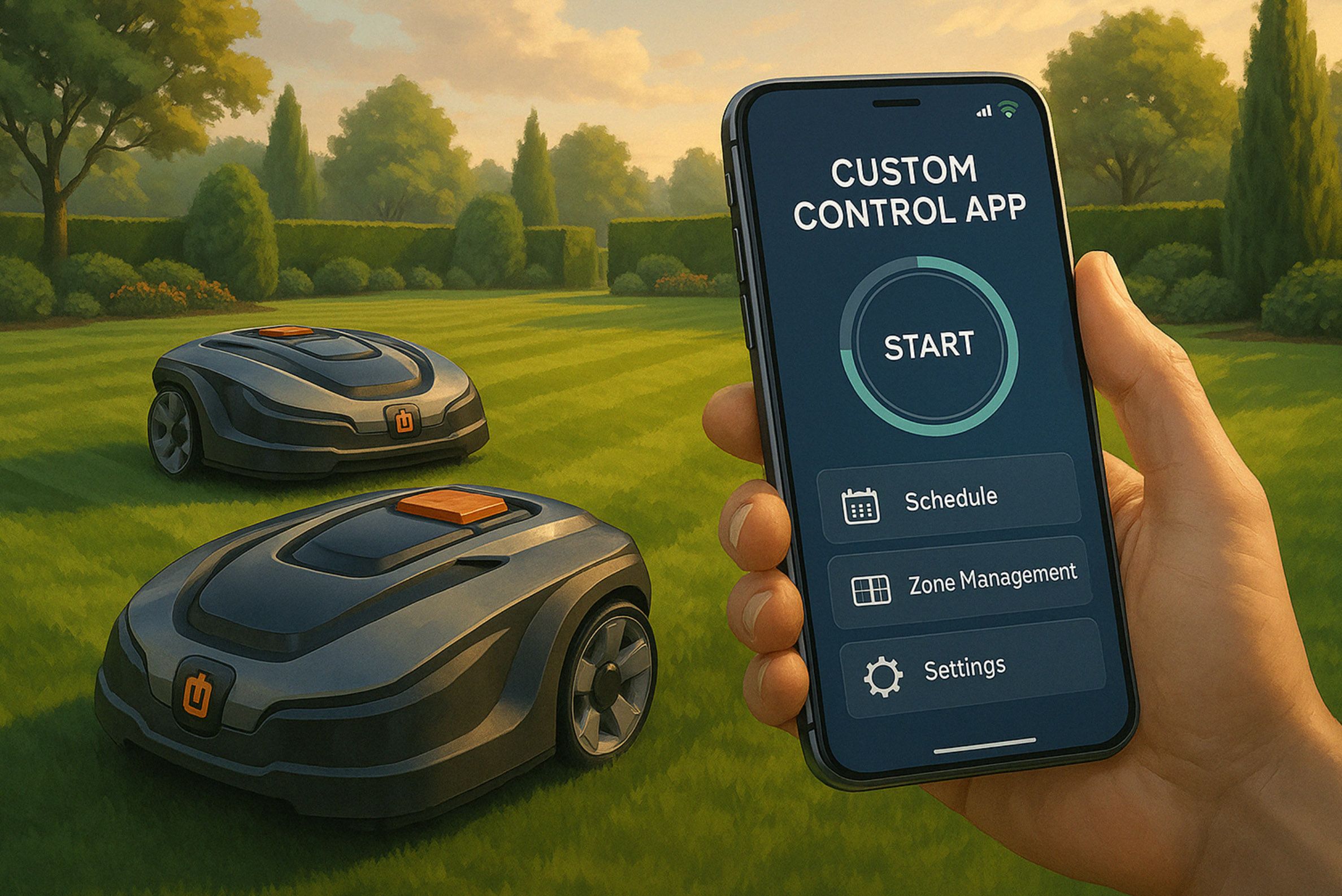
2. Market Overview: The Booming Robotic Lawn Mower Industry
The global shift toward automation and smart home integration has reached the lawn care industry, and robotic lawn mowers are at the forefront of this transformation. Once considered a novelty, these autonomous machines are now becoming standard equipment for homeowners, landscapers, and even facility managers seeking efficient and eco-friendly solutions.
According to a comprehensive report by Arizton, the global robotic lawn mower market was valued at $2.27 billion in 2023 and is projected to reach $4.33 billion by 2029, growing at a compound annual growth rate (CAGR) of 11.35% during the forecast period. North America is a major contributor to this growth, alongside Western Europe and parts of Asia-Pacific. Factors such as aging populations, rising labor costs, and increasing consumer demand for smart, low-maintenance solutions are fueling adoption.
North American Landscape
In the United States alone, the robotic lawn mower market is expected to reach $704.5 million by 2027, more than doubling from its 2021 value of $351 million. According to Arizton’s North American Market Report, the compound annual growth rate in the U.S. is projected to exceed 12%, outpacing traditional lawn care segments. This is particularly relevant in suburban markets, where over 80 million single-family homes have private lawns — a massive opportunity for automation.
Canada also demonstrates high growth potential due to its similar housing profile and the country’s push toward carbon neutrality in residential energy and emissions. Battery-powered mowers are viewed as a viable alternative to gas-powered equipment, which contributes significantly to small engine pollution.
Technological Adoption & User Expectations
The surge in robotic lawn mower adoption is closely tied to smart home proliferation. Homeowners increasingly expect their appliances — from thermostats to vacuum cleaners — to be connected, customizable, and remotely controllable. Lawn care is no exception. However, while many robotic mowers offer basic app functionality (such as start/stop commands or scheduling), users are now demanding deeper integration, enhanced mapping, better AI-driven navigation, and seamless connectivity with other smart devices.
“Consumers want their outdoor tech to be as smart as their phones,” says Matt Reimer, a smart agriculture researcher at the University of Manitoba. “People aren’t just buying machines anymore — they’re buying convenience, control, and long-term intelligence.”
This mindset opens the door for custom mobile app development, especially as off-the-shelf solutions often fail to meet these evolving expectations.
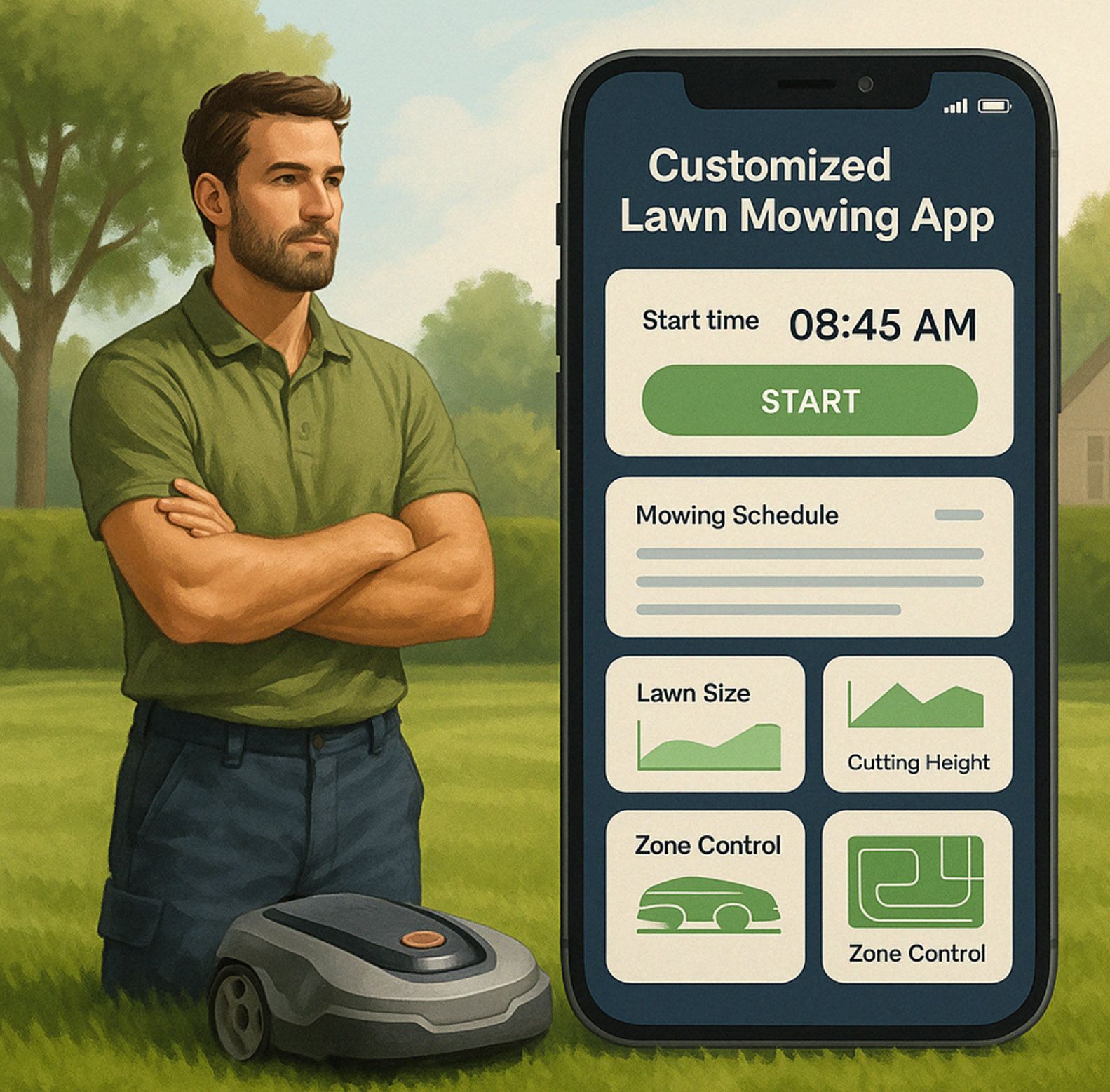
Market Segments: Residential and Commercial
While the residential segment dominates, commercial adoption is rapidly increasing. Landscaping companies, real estate developers, hotels, golf courses, and university campuses are exploring robotic lawn mowers to reduce labor dependency and standardize grounds maintenance. In these contexts, advanced features like multi-unit control, GPS-based zone management, and integration with weather APIs become crucial — and most mass-market apps fall short.
This is where custom apps offer a significant competitive edge. They allow businesses to create branded, enterprise-ready interfaces tailored to their operational workflows, rather than being constrained by generic consumer tools.
White Space for Innovation
Despite the market growth, there's still a significant gap in the software layer of robotic lawn care. Many hardware manufacturers focus heavily on engineering the physical product while treating the mobile app as an afterthought. This has led to poor UX, inconsistent functionality across platforms, and a lack of support for advanced features like AI-driven mowing path optimization, voice assistant integration, or multi-device dashboards.
For companies like A-Bots.com, this represents an ideal entry point — a chance to build world-class mobile applications that match the sophistication of modern robotic mowers and fulfill the expectations of 21st-century homeowners.
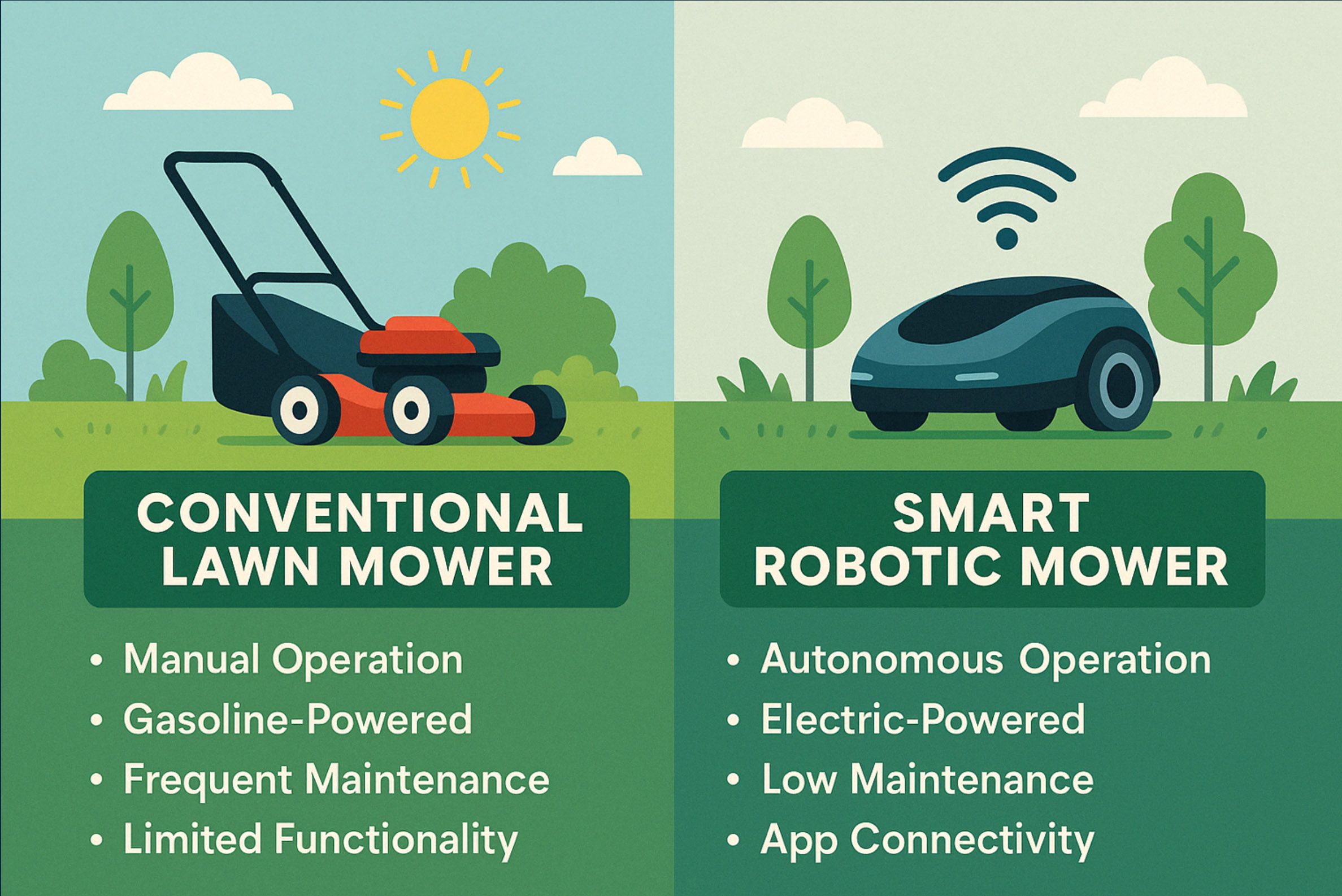
3. Understanding Smart Lawn Mowers: Features and Benefits
To understand why custom mobile apps are essential for modern robotic lawn mowers, we must first understand the machines themselves — not just as hardware, but as complex autonomous systems designed for dynamic real-world environments.
A smart lawn mower is no longer a glorified Roomba with blades. It’s an integrated robotic system that combines sensor fusion, real-time localization, path planning algorithms, and connectivity protocols, all running on constrained embedded platforms. In many ways, it’s closer to a mobile robot in an industrial warehouse than to a traditional gardening tool.
At the core of most premium smart mowers is a multi-sensor navigation system. Entry-level models typically rely on perimeter wire systems to define mowing areas, but higher-end devices now utilize RTK-GPS, inertial measurement units (IMUs), ultrasonic sensors, and visual SLAM (simultaneous localization and mapping) via onboard cameras. This allows them to map, localize, and adapt to changing outdoor environments — slopes, flower beds, kids' toys, and even unpredictable weather.
But intelligence isn’t only about how a mower moves — it’s also about how it communicates. And that’s where software, especially mobile software, becomes mission-critical. A well-designed app should serve as the operator’s control tower — a unified interface that combines setup, scheduling, analytics, and remote intervention. However, most existing apps provide only a fraction of this capability.
What’s missing is true user-centricity. The average homeowner wants the mower to do more than just follow a schedule. They want to define mow-free zones with a few taps, change paths on the fly based on weather forecasts, view real-time status on a live map, and integrate with their smart home routines (e.g., pause mowing when someone is on the patio or when rain starts). These expectations mirror those from the smart vacuum or thermostat space, and failing to meet them feels like a step backwards.
Beyond convenience, smart mowers also bring serious functional benefits. They cut grass more frequently and with greater consistency than manual mowing, leading to healthier turf due to mulching techniques. They consume less energy than traditional gas mowers and contribute to noise reduction — a major factor in residential satisfaction.
Moreover, the benefits scale in commercial settings. For landscaping companies, robotic mowers mean predictable outcomes, fewer staffing problems, and tighter operational control. But to unlock that potential, they need multi-unit management interfaces, task logging, alert systems, and integration with fleet management tools — all of which can be achieved through a robust custom mobile app.
According to a 2024 study by ResearchAndMarkets, the top reason homeowners hesitate to adopt robotic mowers is not the cost, but poor or unintuitive software experiences. This suggests that the mobile app is now a decisive factor in purchase decisions — not just an accessory.
What we’re witnessing is the transformation of a lawn mower into a connected agent — one that collaborates with other smart systems, learns from its environment, and communicates with the user in real-time. The hardware might roam the lawn, but it’s the app that defines the experience.
And that’s precisely why brands that invest in better software — especially custom, purpose-built mobile apps — are the ones that will dominate the next generation of lawn care.
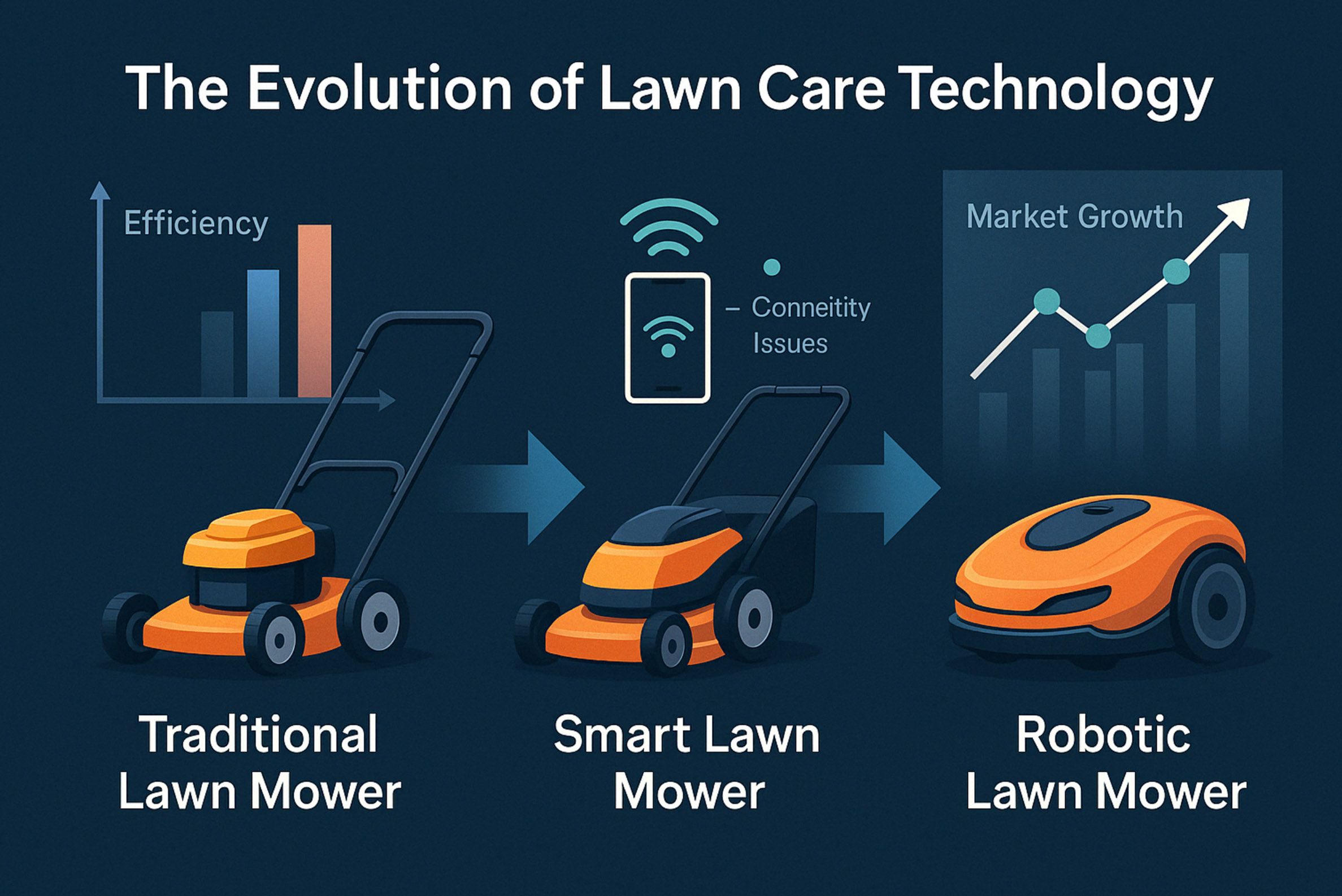
4. The Role of Custom Mobile Apps in Enhancing User Experience
Smart lawn mowers are autonomous by design — but autonomy without transparency, control, and feedback is ultimately frustrating. It’s the mobile app interface that transforms an autonomous machine into a meaningful tool — one that aligns with human expectations, adapts to complex scenarios, and evolves with use.
Yet in today’s market, most default mobile apps bundled with robotic mowers fall short. They are often overly simplified, inconsistent across platforms, lacking in real-time data, and fail to leverage the full potential of the underlying hardware. In many cases, the app becomes the weakest link in the product ecosystem — despite being the primary touchpoint between the user and the device.
That’s where custom mobile apps enter the picture — not as cosmetic enhancements, but as strategic assets that can define the success of a lawn tech product.
From Remote Control to Personalized Intelligence
A truly valuable custom app goes far beyond basic remote control. It becomes a control center, a command interface, and, eventually, a smart assistant for outdoor automation. Through thoughtful UX design and full-stack integration with the robot’s firmware, cloud backend, and third-party APIs, a custom app can provide:
- Context-aware scheduling (e.g. delay mowing due to upcoming rain via weather API).
- Dynamic zone creation using GPS or map-based interfaces.
- Real-time tracking with visual status overlays and path logs.
- Notifications that actually matter — low battery, stuck blades, pet detected in yard.
- User profiles and seasonal presets (e.g., “Spring Growth Mode”, “Dry Climate Mode”).
These features are not just technical upgrades. They fundamentally change how the user perceives the product. A mower that simply “runs every day at 10 AM” is fine. But a mower that “detects weather, adapts to grass growth, avoids birthday parties, and updates itself silently overnight” — that’s magical.
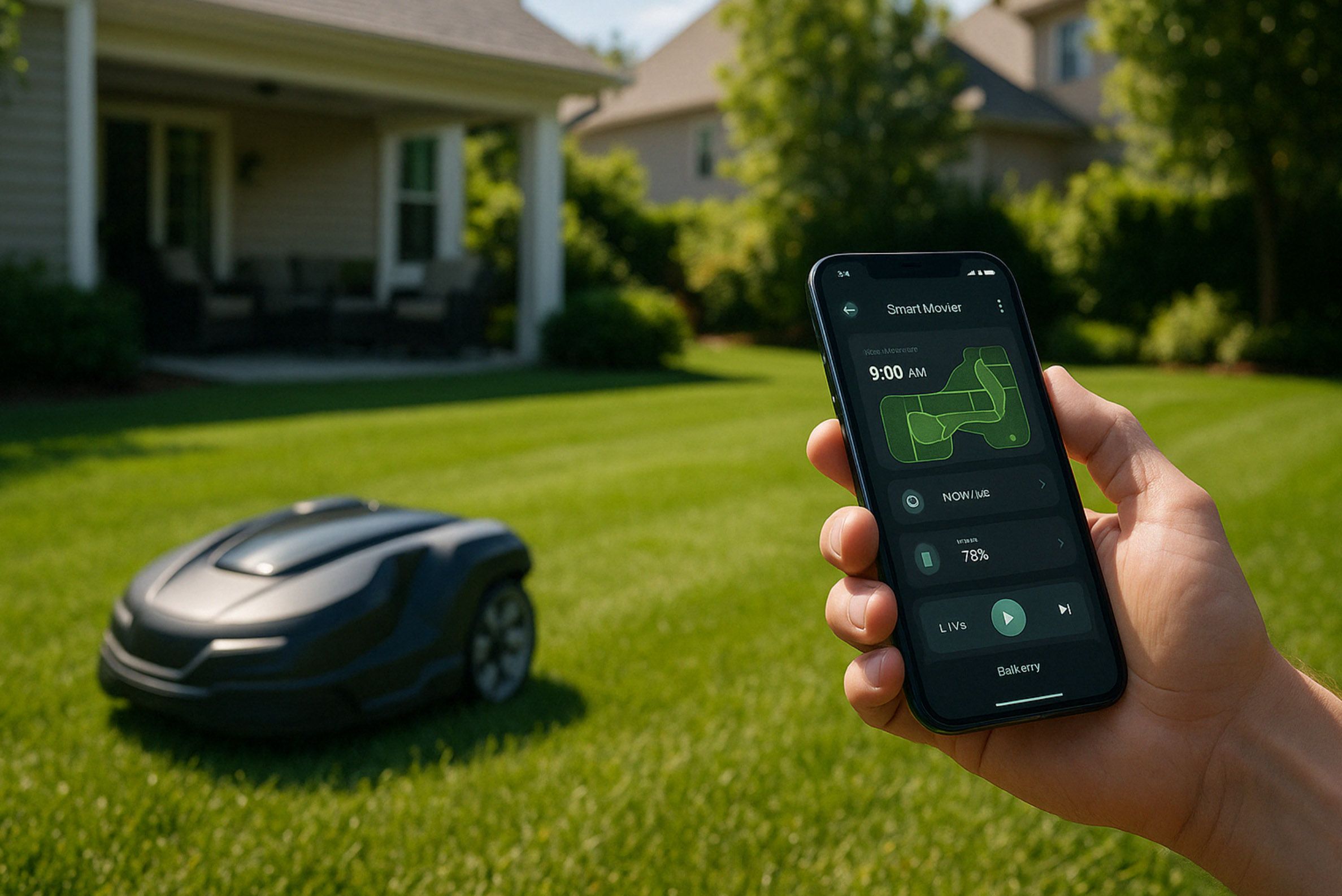
Custom UX for Real-World Diversity
Every lawn is different. Every user is different. And yet most robotic mower apps treat all users as the same. A well-crafted custom app can introduce user-specific UX flows: for elderly homeowners, for property managers, for commercial groundskeepers. Each persona can get a different interface: more automation, more analytics, or more control — depending on their needs.
Moreover, brand consistency becomes a serious concern in premium markets. Manufacturers who sell high-end equipment cannot afford to offer apps that look like they were made for a $30 gadget. With a custom solution, every pixel can reflect the tone, quality, and attention to detail that customers expect from the hardware itself.
Multi-Device and Smart Home Integration
A fully capable app should not live in isolation. Through custom development, it can become part of a larger smart ecosystem:
- Voice command via Alexa or Google Home.
- Integrations with smart irrigation systems (pause watering during mowing).
- Shared access and permissions for family members or staff.
- Enterprise-level dashboards for fleet monitoring (ideal for commercial mowers).
These features are rarely available — or even feasible — in off-the-shelf or OEM-developed apps. Only custom-built apps can accommodate the unique demands of B2B customers or the nuanced expectations of high-end residential users.
Business Impact: From Utility to Loyalty
There’s a business case too. A superior app experience leads to:
- Lower churn (users stick with the brand longer),
- Higher NPS scores,
- More upsells (e.g., service subscriptions, add-ons, accessories),
- Deeper data capture (for improving hardware, training AI, and targeting marketing).
Put simply: the app is not an accessory — it’s the brand experience. And brands that understand this will not only sell more robotic mowers, they’ll build stronger relationships with customers over time.
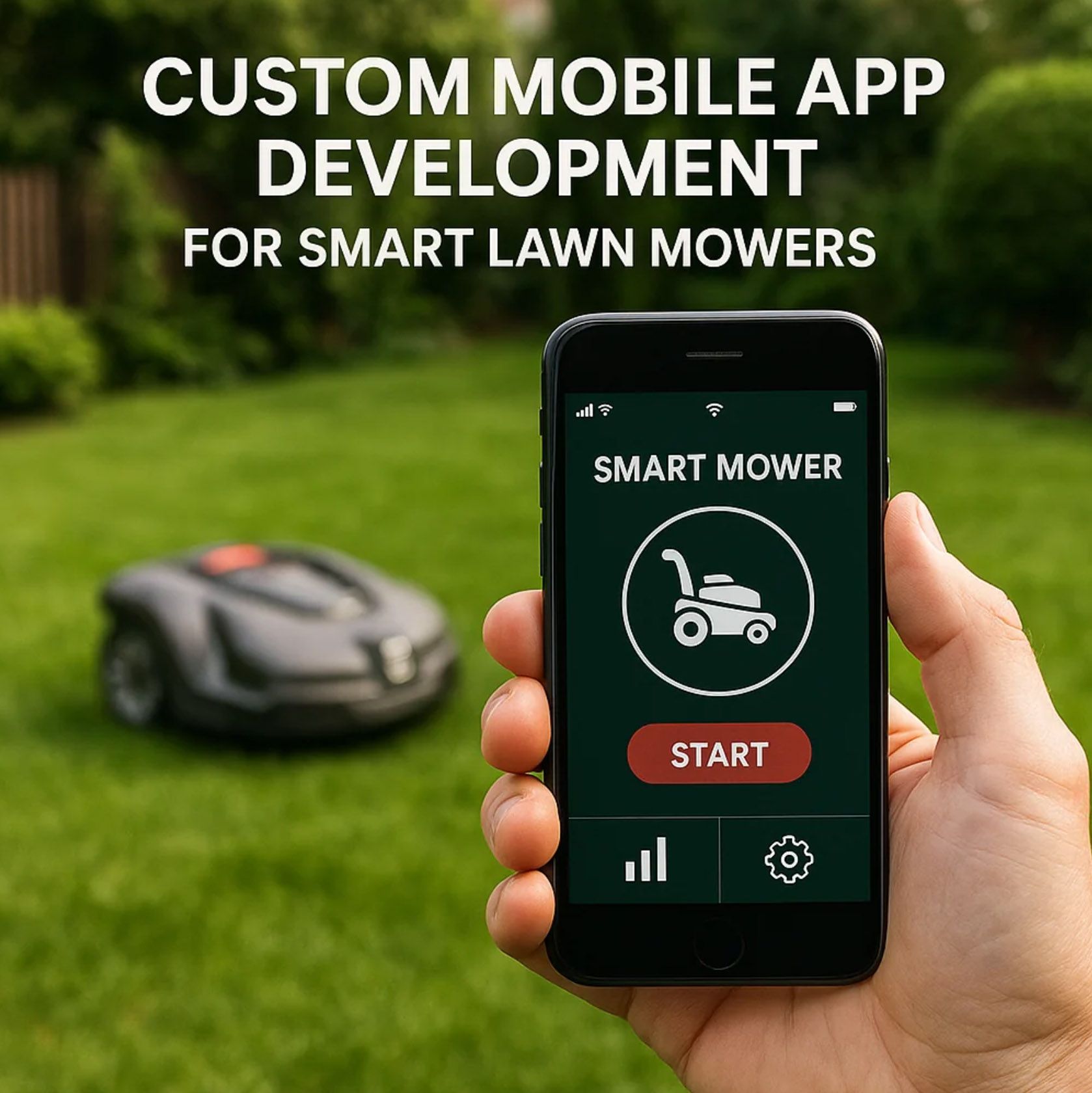
5. Technical Architecture: Building Robust and Scalable Solutions
Behind every seamless mobile experience for a smart lawn mower lies a complex, distributed system — one that must reliably coordinate between hardware, embedded software, the cloud, and the mobile app in real time. Designing such architecture isn’t just about adding “connectivity”; it’s about building a resilient, secure, and scalable platform capable of operating outdoors, unattended, and sometimes under poor network conditions.
At its core, the smart mower’s architecture includes four key layers:
5.1. Device Layer: Embedded Systems and Firmware
This is the heart of the robotic mower — a tightly constrained embedded platform that must operate continuously, handle edge-case navigation, and ensure physical safety. It includes:
- Real-time OS (RTOS) or microcontroller-based firmware
- Sensor processing (IMUs, ultrasonic, cameras, GPS, encoders)
- Motor control loops for steering, blade engagement, lift detection
- Connectivity modules (Bluetooth Low Energy, Wi-Fi, LTE-M, or LoRa)
The firmware must expose a robust command-response interface — either via BLE characteristics, WebSockets over local Wi-Fi, or secure RESTful APIs if cloud-based control is used.
5.2. Connectivity Layer: Local and Cloud Communication
Modern mowers often support dual connectivity: local control via Bluetooth/Wi-Fi, and remote control via cellular or cloud relay. This layer includes:
- MQTT brokers for lightweight, real-time messaging
- CoAP or HTTPS APIs for settings, scheduling, and diagnostics
- OTA (Over-the-Air) update support, with firmware validation and rollback
- End-to-end encryption with TLS 1.3 and key-based authentication
The choice of connectivity affects battery life, responsiveness, and complexity. Custom apps can be optimized to prefer low-latency local control when nearby, and fall back to cloud when remote.
5.3. Cloud Infrastructure and Data Management
The cloud backend acts as the persistent brain of the system — managing users, devices, sessions, and analytics. A scalable setup typically includes:
- AWS IoT Core, Azure IoT Hub, or Google Cloud IoT Core
- Serverless compute (Lambda, Cloud Functions) for low-latency events
- NoSQL databases (DynamoDB, Firestore) for user/device data
- Time-series storage for logs, mower paths, error telemetry
- AI model hosting for predictive maintenance or grass growth optimization
Custom apps can leverage this infrastructure for features like user profiles, zone maps, mowing history, and energy consumption dashboards.
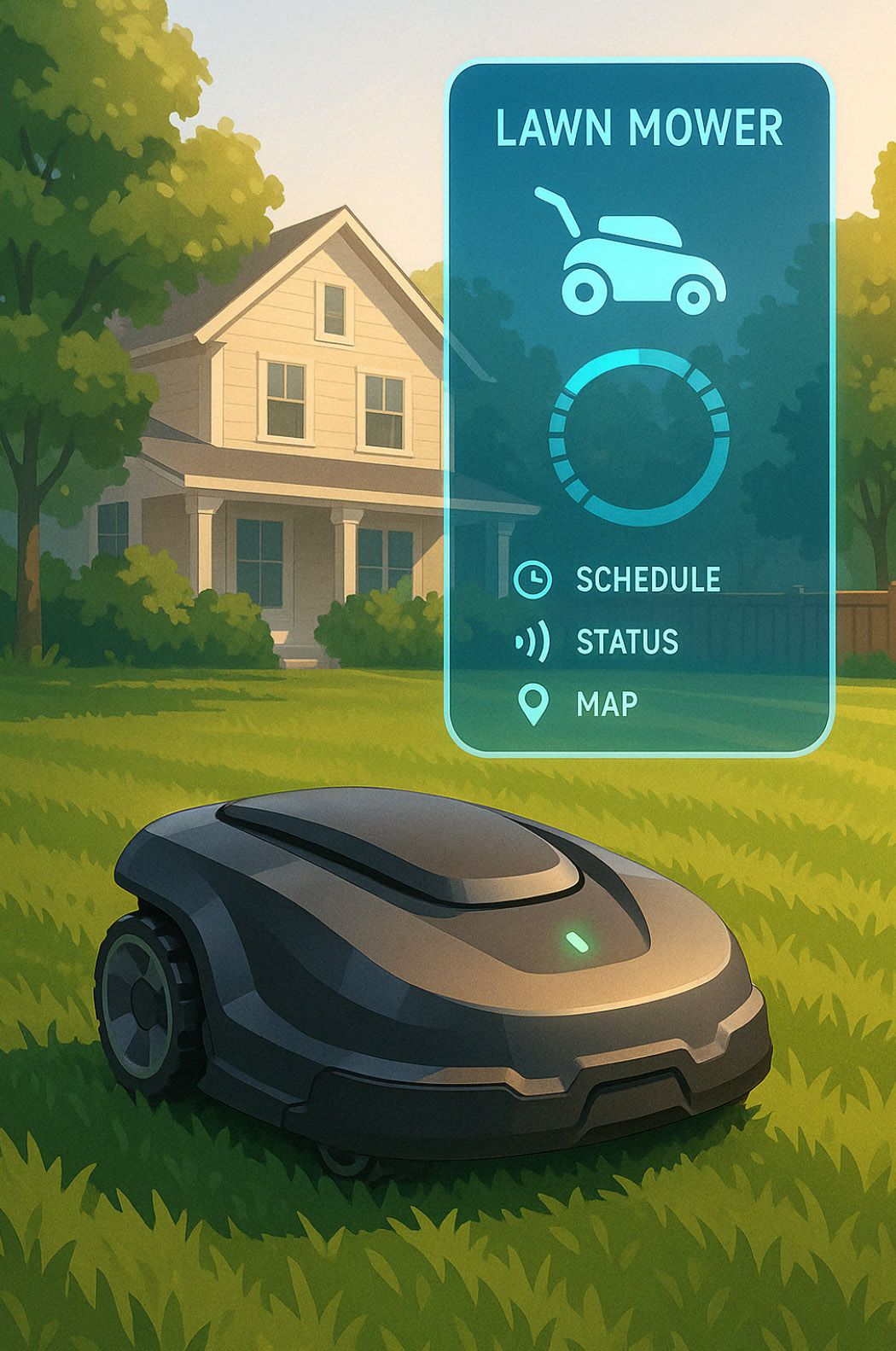
5.4. Mobile Application Layer
The app is the final — and most visible — layer. It must be fast, intuitive, visually refined, and tightly integrated with the cloud and device. A robust app should include:
- Cross-platform support (Flutter, React Native) or native Swift/Kotlin for premium apps
- BLE/Wi-Fi protocol handling, with reconnection logic and fallback
- Offline support with sync queues and caching
- Push notifications using Firebase Cloud Messaging or APNs
- Dynamic UI rendering based on mower model, region, and user settings
The best custom apps treat the user not just as an operator, but as a co-pilot. They surface meaningful data, hide unnecessary complexity, and offer enough control without overwhelming.
Security and Compliance
Given the remote nature of operation and the possibility of physical harm (blades, movement), security is paramount. A complete architecture must include:
- Device authentication and pairing codes
- Encrypted firmware updates (sign-and-verify)
- GDPR/CCPA-compliant data handling
- Audit logs for commercial customers
Modular Design for Scalability
Custom architecture should be designed modularly, enabling:
- Easy onboarding of new mower models
- White-label deployment for OEMs
- Custom feature toggling by region, language, or market
- Analytics integration (e.g., Amplitude, Mixpanel)
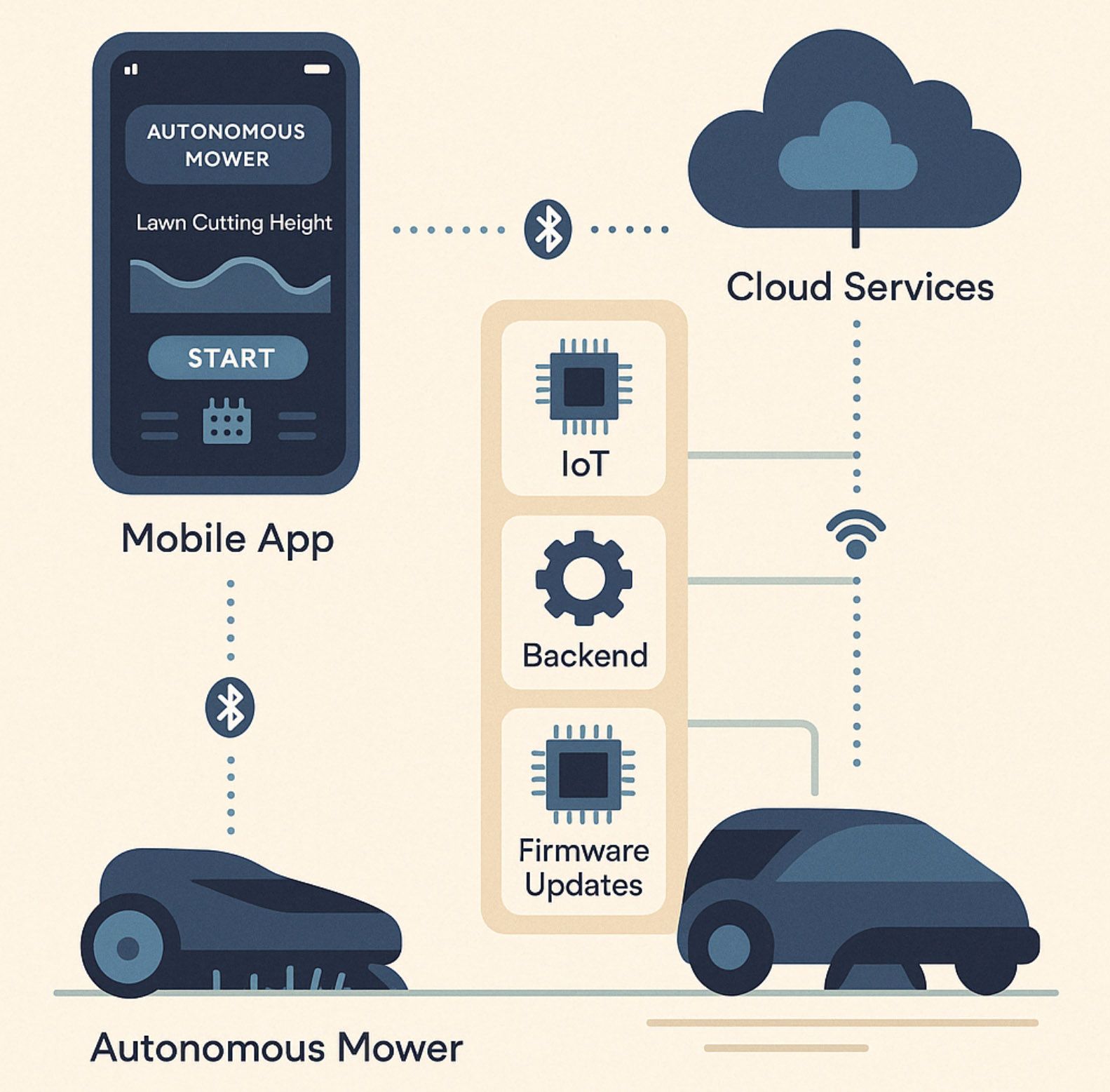
6. Challenges and Solutions in Developing Lawn Care Apps
At first glance, building a mobile app for a smart lawn mower might seem no more complicated than creating a standard IoT dashboard. But in reality, it’s a multilayered challenge that brings together outdoor robotics, real-time connectivity, safety-critical systems, and demanding user expectations — all within the constraints of mobile UX.
One of the most underestimated challenges is environmental unpredictability. Unlike indoor robots, lawn mowers operate in harsh, uncontrolled conditions. The device must be able to respond to fluctuating GPS accuracy due to tree cover or buildings, deal with terrain variations such as hills or wet grass, and navigate around moving obstacles like pets or children. For the app, this means that the data being displayed — mower position, activity status, diagnostics — is always subject to change and degradation. Designing an interface that gracefully handles inconsistencies, latency, or signal loss is far more complex than simply “displaying sensor values.”
Another fundamental challenge lies in real-time bi-directional communication between the app and the mower. When the device is on Wi-Fi, latency can be acceptable, but many users expect remote control over LTE or cloud APIs — and that introduces serious architectural concerns. Commands must be queued, acknowledged, retried. State must remain consistent between device and app. If a user sets a new mowing schedule while on a business trip and it doesn’t sync due to poor error handling, the trust is lost. Worse yet, if the mower runs during a family gathering by mistake — the experience is not just frustrating, it’s damaging to brand reputation.
From a UX standpoint, the biggest hurdle is finding the right level of abstraction. Too much technical detail, and the average user is overwhelmed. Too little, and power users or commercial clients feel constrained. This becomes even more important when supporting different mower models with different capabilities — like multi-zone navigation, obstacle memory, or 3D mapping. A custom app must be smart enough to adapt its interface dynamically based on model, firmware version, or even the user’s role (e.g. homeowner vs. groundskeeper). That level of adaptive UI requires a solid design system and tight collaboration between engineering and product teams.
Security adds another layer of complexity. Since these devices involve physical motion and cutting components, they must be protected from spoofing, hijacking, or misconfiguration. Pairing flows must be secure, device authentication must be enforced, and firmware updates need cryptographic validation — yet all of this must happen invisibly to the user. It’s a classic paradox: maximum safety, with minimum friction. Only a deeply customized application can strike that balance.
And finally, we must address the challenge of user trust and emotional design. A lawn mower that disappears into the garden and silently performs its duties is amazing — until something goes wrong and the user is left wondering what happened. The app must act as a transparent layer that explains the machine’s behavior, anticipates potential confusion, and provides timely feedback. Good app design reduces support tickets. Great app design builds confidence.
There are no shortcuts here. Off-the-shelf frameworks or OEM apps tend to solve only the easiest 80% of use cases. But the final 20% — the polish, the robustness, the intelligence — is what creates a product people love and recommend. Solving these challenges requires not just developers, but a multidisciplinary team of roboticists, UX designers, systems engineers, and user psychologists. And that’s precisely where custom development firms like A-Bots.com make the difference — not by adding more features, but by solving the right problems, elegantly.
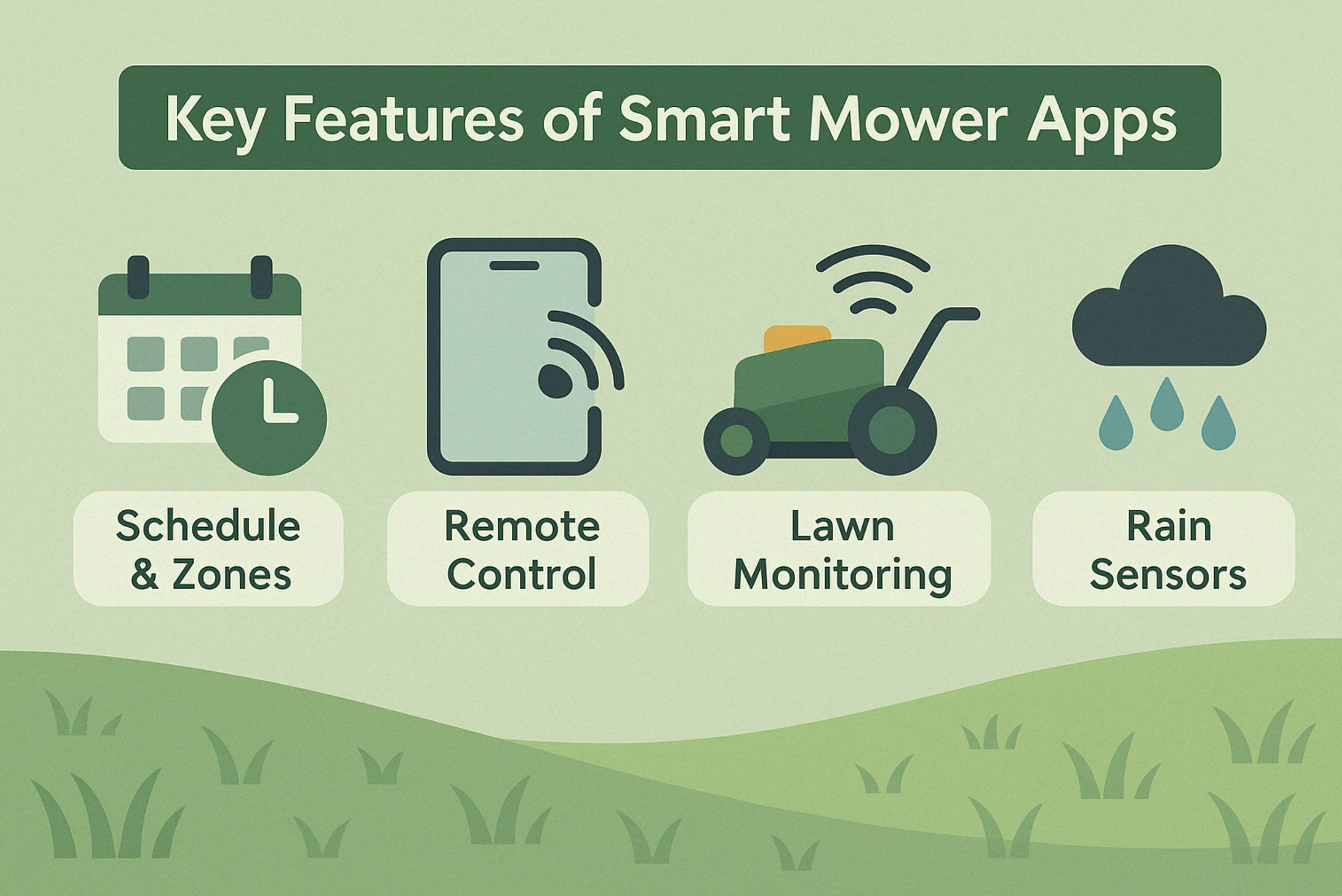
7. Why Choose A-Bots.com for Your Smart Lawn Mower App Development
In a marketplace where the line between hardware and user experience grows thinner with each generation of smart devices, the quality of the accompanying software is no longer optional — it is the product. A robotic lawn mower may cut grass with precision, navigate with sensors, and charge autonomously, but without a thoughtfully designed and technologically sound app, the experience is incomplete, and often disappointing.
This is precisely where A-Bots.com stands apart.
Unlike traditional development agencies or hardware vendors with an app as an afterthought, we approach connected devices — especially autonomous outdoor robotics — as living systems. Every detail we design, every architecture we implement, is based on an understanding that the mobile app is not just a controller. It is the voice of the product. It’s the interface where engineering meets psychology, where complexity is translated into simplicity, and where the brand is experienced every single day.
Our strength lies in specialization. At A-Bots.com, we focus exclusively on mobile applications for smart devices — with a deep emphasis on IoT, robotics, and UX in real-world environments. We’ve built apps for connected appliances, autonomous cleaning systems, and precision agriculture — and we understand the edge cases, the architectural bottlenecks, and the behavioral patterns of users who don’t just tap screens but expect invisible intelligence behind them.
We also understand what makes lawn tech different. Mowers operate outdoors, often on unpredictable schedules, sometimes without connectivity, and always with an element of physical risk. Designing apps for such machines requires more than UI polish — it requires deep architectural rigor. From robust offline handling and fault-tolerant sync to OTA firmware coordination and zone mapping UX, we’ve done the hard parts that most teams only learn after their first product launch goes wrong.
But our expertise is not only technical. It’s strategic. We don’t just write code — we help you define the product. Whether you're a hardware startup bringing your first prototype to life, or an established brand looking to modernize legacy systems with a custom digital layer, we guide you through every stage: user research, feature architecture, branding, compliance, and post-launch evolution.
More importantly, we build with the long view in mind. Our apps are modular, scalable, white-label-ready if needed, and designed for years of support — not quick exits. Because in the connected device world, customer retention doesn’t come from flashy features. It comes from trust. And trust is built on reliability, responsiveness, and relevance. That’s what we deliver.
Choosing A-Bots.com means choosing a partner who treats your smart lawn mower not as a machine to be “connected,” but as a sophisticated platform for user engagement, brand storytelling, and future innovation. We don’t just build apps — we build relationships between humans and machines.
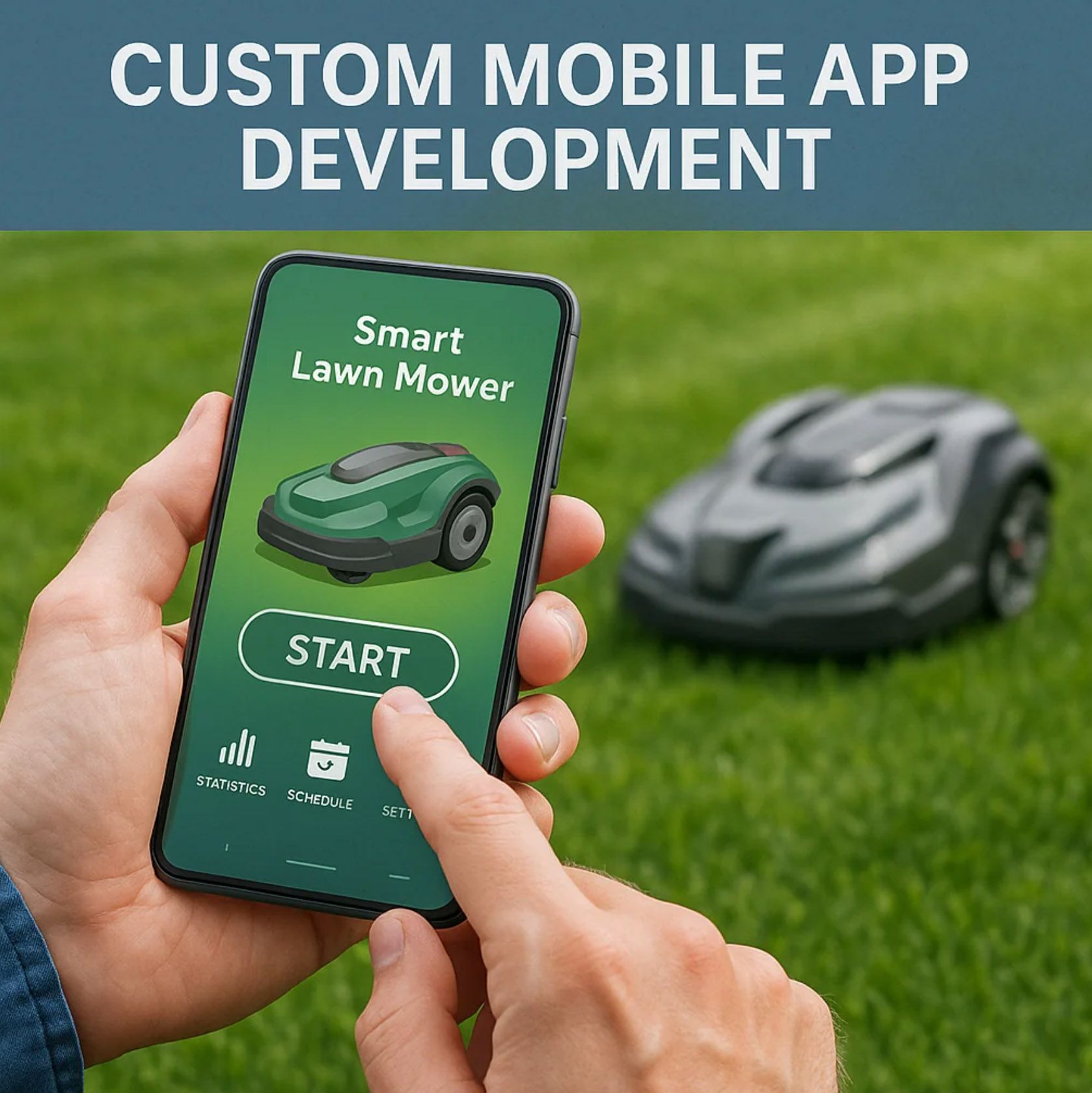
8. Conclusion: Cutting Into the Future
Technology doesn’t just improve tools — it transforms the way we relate to them. What was once a noisy, fuel-powered ritual of pushing metal across grass has evolved into a quiet, intelligent process that happens almost invisibly. The lawn still gets trimmed. But the experience — the control, the feedback, the sense of effortless harmony — is now digital.
Robotic lawn mowers represent one of the most elegant examples of how automation can meet everyday life. They are not about novelty, or even convenience alone. They’re about time reclaimed, tasks delegated, and beauty maintained — without the friction of manual labor. But all of that potential hinges on one thing: how the user interacts with the machine. And in today’s world, that interaction lives entirely inside the app.
This is why mobile software for smart lawn mowers is not a side project or an accessory. It is the beating heart of the user experience. It is where the product’s intelligence is perceived, where the brand is felt, and where trust is either won — or lost. A mower may have the best sensors and motors in the world, but if the app feels clunky, confusing, or limited, the whole product suffers.
Conversely, a thoughtfully designed, well-engineered custom mobile app doesn’t just make the mower more usable. It makes it remarkable. It anticipates user needs. It learns from context. It simplifies complexity. It becomes part of the homeowner’s lifestyle, or the landscaper’s workflow — not another remote, but a smart, adaptive companion. A-Bots.com is mobile app developer company.
And for manufacturers and service providers, this is a strategic lever. The app is the gateway to long-term engagement, feedback loops, premium services, and product differentiation. In a world where hardware gets commoditized fast, the software experience is where loyalty is built.
At A-Bots.com, we believe the future of lawn care — and of many other “ordinary” home technologies — will be defined by how well we design the invisible layers. We help our partners build those layers with precision, clarity, and vision.
So if you're creating the next generation of smart mowers — or looking to upgrade an existing one — the opportunity is right now. The grass will keep growing. The lawns will need mowing. But the way people engage with these tasks is changing forever.
Let’s build the future of lawn care — together, one line of code at a time.
Hashtags
#SmartLawnMower
#LawnTech
#IoTApps
#CustomAppDevelopment
#RobotMower
#SmartHome
#AutonomousLawnCare
#GreenTech
Other articles
Custom CRM for Real Estate Developers
Off-the-shelf CRM tools weren’t built for the complexity of real estate development — but we were. This in-depth article explores why custom CRM solutions are redefining how developers manage projects, leads, teams, and revenue. See real-world ROI calculations, key challenges, and expert insights from A-Bots.com, a top CRM development company.
Custom Agriculture App Development for Farmers In 2024, U.S. farmers are more connected than ever — with 82% using smartphones and 85% having internet access. This article explores how mobile applications are transforming everyday operations, from drone-guided field scouting to livestock health tracking and predictive equipment maintenance. It examines why off-the-shelf apps often fail to address specific farm needs and how collaborative, farmer-funded app development is gaining momentum. Through real-world examples and step-by-step guidance, readers will learn how communities of growers can fund, design, and launch custom apps that fit their exact workflows. A-Bots.com offers tailored development services that support both solo farmers and agricultural groups. With offline capabilities, modular design, and support for U.S. and international compliance, these apps grow alongside the farm. Whether you're planting soybeans in Iowa, raising cattle in Texas, or running a greenhouse in California — this article offers the tools and inspiration to build your own farm technology. Discover why more farmers are saying: we don’t wait for the future — we build it.
Custom Drone Mapping Software & Control Apps: Smarter Aerial Solutions by A-Bots.com Custom drone software is revolutionizing how industries operate—from precision agriculture to infrastructure inspection. This article explores why off-the-shelf apps fall short, how AI and modular design shape the future, and how A-Bots.com delivers tailored drone solutions that truly fit. Whether you manage crops, assets, or entire projects, the right software lifts your mission higher.
Custom IoT for Smart Greenhouses and Vertical Farms Modern greenhouses and vertical farms demand more than off-the-shelf solutions. In this article, discover how custom IoT systems — built around your space, your crops, and your team — can unlock new levels of efficiency, automation, and yield. Packed with real-world examples, insights from A-Bots.com engineers, and expert advice, this guide will inspire your next step in smart agriculture. If you're ready to grow smarter — start here.
Custom Coffee Machine App Development Smart coffee is no longer just about flavor — it's about experience. Discover how custom mobile apps for coffee machines unlock new revenue streams, elevate user engagement, and enhance brand loyalty. Backed by real IoT projects, A-Bots.com delivers world-class app solutions that blend tech with taste. Brew the future with us.
Custom Mobile App Development for Smart Wine Cabinets Smart wine cabinets are revolutionizing how wine is stored, served, and experienced. But without a tailored mobile app, their potential remains untapped. This article explores how custom app development turns connected appliances into lifestyle platforms. From inventory tracking and AI-powered recommendations to enterprise-grade restaurant integrations, the right app changes everything. We cover technical architecture, design principles, and real-world use cases. Whether you're a wine lover, hotelier, or hardware brand, you'll discover why mobile UX is now core to wine storage. A-Bots.com delivers expert, future-ready solutions tailored to this niche.
Top stories
Copyright © Alpha Systems LTD All rights reserved.
Made with ❤️ by A-BOTS
